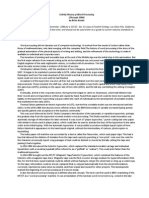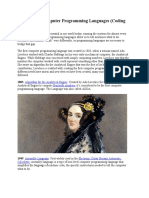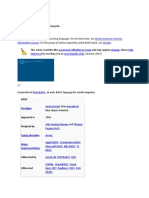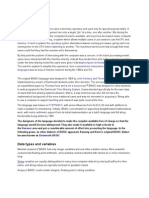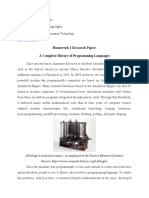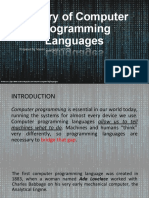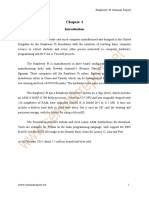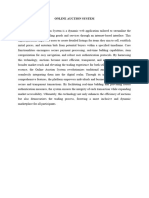100%(1)100% found this document useful (1 vote)
312 viewsHistory of BASIC
History of BASIC
Uploaded by
Christopher John GarciaThe Story of BASIC that I wrote for Core
Copyright:
Attribution Non-Commercial (BY-NC)
Available Formats
Download as DOC, PDF, TXT or read online from Scribd
History of BASIC
History of BASIC
Uploaded by
Christopher John Garcia100%(1)100% found this document useful (1 vote)
312 views3 pagesThe Story of BASIC that I wrote for Core
Copyright
© Attribution Non-Commercial (BY-NC)
Available Formats
DOC, PDF, TXT or read online from Scribd
Share this document
Did you find this document useful?
Is this content inappropriate?
The Story of BASIC that I wrote for Core
Copyright:
Attribution Non-Commercial (BY-NC)
Available Formats
Download as DOC, PDF, TXT or read online from Scribd
Download as doc, pdf, or txt
100%(1)100% found this document useful (1 vote)
312 views3 pagesHistory of BASIC
History of BASIC
Uploaded by
Christopher John GarciaThe Story of BASIC that I wrote for Core
Copyright:
Attribution Non-Commercial (BY-NC)
Available Formats
Download as DOC, PDF, TXT or read online from Scribd
Download as doc, pdf, or txt
You are on page 1of 3
Basic
By
Christopher Garcia
Appeared in CORE 3.3, January 2002
In the earliest days of computing, batch processing ruled.
A programmer would take a deck of punched cards they had
punched off-line, give them to the operator and wait,
sometimes days, for the results to come back. The need for
a system where many Users could act as their own oOperators
on a single machine brought helped bring about the BASIC
language.
So, BASIC, the 'Beginners All-purpose Symbolic Instruction
Code', was written in the early 1960s by two Dartmouth
mathematics pProfessors, Thomas Kurtz and John Kemeny. The
intent was to have a language that was easy to learn that
could be used on the GE225 time-sharing system that
Dartmouth was about ready to launch. The pair thought that
the most popular languages of the day, including Fortran
and ALGOL, were too complex for non-technical users. Using
elements from other languages, and adding elements like
line numbers to make trouble shooting easier, Kemeny and
Kurtz developed BASIC, at first only having 14 commands,
including the famous GOTO. BASIC could be learned in as
little as two sessions, a tremendous advantage over other
languages that could take months.
The time-sharing system would allow many users to log in at
the same time, running programs remotely via terminals
around the campus in the Mathematics and Science
departments. BASIC may have been the first language written
with the intent of it being used by non-computer
professionals.
Many early time-sharing systems used BASIC, including those
powered by GE machines and DEC PDP-11 systems.
BASIC began to show up in many elementary schools around
the country, particularly in cities where school districts
could use Teletypes to get at uUniversity mMainframe tTime
sSharing systems. Children as young as seven were learning
BASIC as a part of their curriculum. This early
introduction made sure that BASIC would continue to evolve.
When the microprocessor was introduced in the early 1970s,
many of the young people introduced to BASIC in elementary
schools started building computers from kits and went on to
start companies. It should be no surprise that many early
microcomputing systems chose BASIC, especially since Kemeny
and Kurtz never patented or copyrighted the language. The
first BASIC considered to be a full language implemented on
a microprocessor was Li Chen Wang's Tiny Basic, which
appeared in Dr Dobbs Magazine in early 1975.
Bill Gates, then a student at Harvard, wrote a BASIC
interpreter for the Altair in March 1975. MicroSsoft,
released their version of BASIC on paper tape later in the
year, once Altairs actually started being delivered. The
tapes were easy to pirate, as you could run it into your
computer and then punch another copy of the tape on a
teletype. Bill Gates wrote an open letter to hobbyists
saying that software copying was theft, and claiming that
for all the work they had put into BASIC for the Altair had
resulted in income of two US dollars an hour. This letter
was published in many of the computer hobbyist magazines
and was the first time people began to think of software
sharing as piracy. It also was the first time people
started to turn against Gates. Some of the hobbyists
believed passionately in the free sharing of software, and
this letter that began to turn them against Gates and
Microsoft- an attitude that persists even today.
Kemeny and Kurtz, the designers of BASIC, released their
own polished version of BASIC called True BASIC. The two
originatorsprofs believed that the variants of BASIC that
companies had been releasing were altering the basic
premise of BASIC, and the 'True BASIC' was to be the
definitive version. It did not sell as well as the other
versions on the market, especially those made by Microsoft.
Many new systems turned to BASIC for introducing people to
computing. In the 1980s, the BBC used a version of BASIC
called BBCBASIC (Occasionally written to BBasiC by the few
Americans who knew anything about it) for the BBCMicro,
later the Archimedes and many other British micros. The BBC
Micro had been designed as part of a BBC plan to introduce
computers to the general population (since Britain had been
lagging to a degree behind the US in the percentage of
homes and classrooms with computers). The machine and the
variant of BASIC are almost unknown in America, though some
believe that it could have caught on in the US with a
proper introduction. There continues to be a strong group
of users who proclaim BBCBASIC to be 'the best, most
powerful BASIC ever written.'
BASIC began to fade away from the limelight when languages
like C and Pascal were implementedgot good compilers and
interpreters for small machines. The beginning of Object-
Oriented Programming (arguably with Alan Kay's SmallTalk)
and languages like C++ put the final nail in the glory days
of BASIC. BASIC The language still exists today in
Microsoft’s QBASIC and a few other products, and also as
Visual BASIC, an object-oriented language developed by
Microsoft, though it is less popular than many of the other
object-orientated programming languages.
Looking Back
Several people point to BASIC as the gateway language, the
first real language to bring computer programming
capabilities to the common person out of the hands of
mathematicians. Ultimately helping make, making computer
science as a separate discipline possible. John Kemeny
passed away in the early 1990s, but Kurtz continues to
speak and write about the early days of BASIC. Recently
however, Kurtz denied the claim that BASIC was the single
most important advancement in the history of programming.
I'm sorry to say, but I don't think we had much
effect...
- Thomas Kurtz
You might also like
- History of The Web BrowserDocument6 pagesHistory of The Web BrowserMeli PonceNo ratings yet
- A Brief History of Word ProcessingDocument2 pagesA Brief History of Word ProcessingVeronica Rivera100% (1)
- A History of Computer Programming LanguagesDocument5 pagesA History of Computer Programming LanguagesDalitso100% (1)
- Virtual Machine Installation Guide: SightlineDocument32 pagesVirtual Machine Installation Guide: SightlineSamuel DiazNo ratings yet
- Node - JS, Socket - Io, and Real-Time Web HMI Example - Chris LarsonDocument17 pagesNode - JS, Socket - Io, and Real-Time Web HMI Example - Chris LarsonmarplemrNo ratings yet
- Intro To Report Writing For Digital Forensics - SANS InstituteDocument4 pagesIntro To Report Writing For Digital Forensics - SANS Institutehemanth.k.raju2982No ratings yet
- Just Basic Programming LangugaeDocument13 pagesJust Basic Programming LangugaeAra LorinoNo ratings yet
- Spread On Minicomputers: IF If I 5 Then Goto 100Document3 pagesSpread On Minicomputers: IF If I 5 Then Goto 100Fe GregorioNo ratings yet
- From Wikipedia, The Free Encyclopedia Jump ToDocument12 pagesFrom Wikipedia, The Free Encyclopedia Jump ToApurvaGawandeNo ratings yet
- History of BASICDocument3 pagesHistory of BASICabdulwasiuwaris4No ratings yet
- OriginDocument2 pagesOriginFe GregorioNo ratings yet
- History of Basic ProgrammingDocument2 pagesHistory of Basic Programmingmuhammed MustaphaNo ratings yet
- PPDocument18 pagesPPZulhilmi ZulkeflleNo ratings yet
- Homework 1 Research Paper: A Complete History of Programming LanguagesDocument12 pagesHomework 1 Research Paper: A Complete History of Programming LanguagesPhúc Hồ ThếNo ratings yet
- Ict Programming "C" Language - Is A General-Purpose, Imperative Computer Programming Language, Supporting StructuredDocument3 pagesIct Programming "C" Language - Is A General-Purpose, Imperative Computer Programming Language, Supporting StructuredMae JoyceNo ratings yet
- Reviewer - Lecture 1&2Document2 pagesReviewer - Lecture 1&2vivianprimavera.vivoNo ratings yet
- Grade 10 Module 3 6Document35 pagesGrade 10 Module 3 6quielyzaondilloNo ratings yet
- Week 6, Level IIDocument12 pagesWeek 6, Level IIYefer Iván Auzaque LeónNo ratings yet
- Trabajo Programación Cristian RegalónDocument8 pagesTrabajo Programación Cristian RegalónCristianNo ratings yet
- Trabajo Programación Cristian RegalónDocument8 pagesTrabajo Programación Cristian RegalónCristianNo ratings yet
- Chapter 1 4 UpdatedDocument35 pagesChapter 1 4 UpdatedaxcelqtmangabatNo ratings yet
- History of Computer ProgrammingDocument11 pagesHistory of Computer Programmingtanlejunior5No ratings yet
- Bs Mls 2B: MOLINA, Christian Dave C. The Five Generations of ComputersDocument5 pagesBs Mls 2B: MOLINA, Christian Dave C. The Five Generations of ComputersDaveNo ratings yet
- Lesson 1Document23 pagesLesson 1kiokocurtisNo ratings yet
- 6diprog - PrelimsDocument7 pages6diprog - PrelimsRV TvNo ratings yet
- The Office 2003 EnvironmentDocument118 pagesThe Office 2003 EnvironmentGIL ExaminationNo ratings yet
- Evolution of Computer Programming LanguagesDocument7 pagesEvolution of Computer Programming Languagesvishnuv123100% (2)
- History of Programming LanguagesDocument51 pagesHistory of Programming LanguagesMohd Ali QadriNo ratings yet
- Visual Basic: Three Modern Basic Variants: Basic, andDocument2 pagesVisual Basic: Three Modern Basic Variants: Basic, andFe GregorioNo ratings yet
- 20th Century Programming Languages TimelineDocument4 pages20th Century Programming Languages Timelinerisilbinmusthafa100% (1)
- Ipt Lesson 1Document44 pagesIpt Lesson 1Canlas John MichaelNo ratings yet
- History of Programming LanguagesDocument12 pagesHistory of Programming LanguagesAsif MujeebNo ratings yet
- History of Programming LanguagesDocument13 pagesHistory of Programming LanguagesSumanth ThipparthiNo ratings yet
- ppl assignmentDocument21 pagesppl assignmentMaryam Mahjabeen YounisNo ratings yet
- App Development (Midterms Reviewer)Document12 pagesApp Development (Midterms Reviewer)vivianprimavera.vivoNo ratings yet
- history of computersDocument2 pageshistory of computersSandro KomunadzeNo ratings yet
- Software Engineering: From Wikipedia, The Free EncyclopediaDocument2 pagesSoftware Engineering: From Wikipedia, The Free Encyclopediaalfonsoar447370No ratings yet
- The Rise of Local Area Networks (Lans) Paved The Way For Network Operating SystemsDocument7 pagesThe Rise of Local Area Networks (Lans) Paved The Way For Network Operating SystemsBede Ramulfo Juntilla SedanoNo ratings yet
- History of C' LanguageDocument1 pageHistory of C' Languagesachin22221No ratings yet
- Computer InventorsDocument10 pagesComputer InventorsEx PertzNo ratings yet
- Activity 1 Logic FormulationDocument4 pagesActivity 1 Logic FormulationRichard Culaton IIINo ratings yet
- Raspberry Pi Seminar ReportDocument32 pagesRaspberry Pi Seminar ReportChowdary Srinivas 143 UppuluriNo ratings yet
- "Pride" Special Subject Bulletin - #66 March 13, 2006 - Page 1 of 10Document10 pages"Pride" Special Subject Bulletin - #66 March 13, 2006 - Page 1 of 10Joey AbrilloNo ratings yet
- Alan Kay Universal Media MachineDocument53 pagesAlan Kay Universal Media Machinetoso11793No ratings yet
- History of Programming Languages - QuoraDocument3 pagesHistory of Programming Languages - QuoraS SpikeNo ratings yet
- The Evolution of TechnologyDocument4 pagesThe Evolution of TechnologyViorel StefanescuNo ratings yet
- History of ComputerDocument5 pagesHistory of ComputerFaizan HaqNo ratings yet
- Intrduction To Programming and HistoryDocument5 pagesIntrduction To Programming and HistoryOnline UserNo ratings yet
- Unit 1Document37 pagesUnit 1Online UserNo ratings yet
- major paper 2Document7 pagesmajor paper 234275zNo ratings yet
- The Spreadsheet at 25: 25 Amazing Excel Examples that Evolved from the Invention that Changed the WorldFrom EverandThe Spreadsheet at 25: 25 Amazing Excel Examples that Evolved from the Invention that Changed the WorldNo ratings yet
- Self-Assessment Questions 1-1: 1. Briefly Discuss The History of Computer Programming. (10 PTS.)Document3 pagesSelf-Assessment Questions 1-1: 1. Briefly Discuss The History of Computer Programming. (10 PTS.)Remedios Capistrano CatacutanNo ratings yet
- Personal Computer History: The First 25 Years: Dan Knight Tip JarDocument4 pagesPersonal Computer History: The First 25 Years: Dan Knight Tip JarFrancisco BritoNo ratings yet
- Assignment # 2: Operating Systems MSIT 621Document7 pagesAssignment # 2: Operating Systems MSIT 621nairdapunk100No ratings yet
- History of C Programming LanguageDocument5 pagesHistory of C Programming LanguageNijanthan Vijayakumar100% (2)
- Generation of Computers: Camarines Sur National High School Icf 7 Learning Activity Sheet Quarter 1, Week 4Document9 pagesGeneration of Computers: Camarines Sur National High School Icf 7 Learning Activity Sheet Quarter 1, Week 4Houstine ErisareNo ratings yet
- Second Generation ComputersDocument4 pagesSecond Generation ComputersJohn James AntipoloNo ratings yet
- Software Revolution: Timeline (In 1970's) : Amdahl Corporation Introduces The Amdahl 470Document18 pagesSoftware Revolution: Timeline (In 1970's) : Amdahl Corporation Introduces The Amdahl 470William L. Apuli IINo ratings yet
- 2 Computer Programming Module 1Document17 pages2 Computer Programming Module 1joel lacayNo ratings yet
- 4Document4 pages4Karren ReyesNo ratings yet
- Mohamed Ali AhmedDocument25 pagesMohamed Ali AhmedSherif Ashraf ElarabyNo ratings yet
- Ict ReviewerDocument9 pagesIct ReviewerMa Cristina DelegenciaNo ratings yet
- Whirling Wheels - Rev. John MillerDocument7 pagesWhirling Wheels - Rev. John MillerChristopher John GarciaNo ratings yet
- ClaimsDepartment All MayDocument251 pagesClaimsDepartment All MayChristopher John GarciaNo ratings yet
- Journey Planet #39 Judge DreddDocument97 pagesJourney Planet #39 Judge DreddChristopher John Garcia50% (2)
- Claims Department - July 2023Document109 pagesClaims Department - July 2023Christopher John GarciaNo ratings yet
- DrinkTank-21st Century Crime FictionDocument25 pagesDrinkTank-21st Century Crime FictionChristopher John GarciaNo ratings yet
- Journey Planet 19 - Doctor WhoDocument100 pagesJourney Planet 19 - Doctor WhoChristopher John Garcia100% (3)
- Exhibition Hall July 2017Document29 pagesExhibition Hall July 2017Christopher John GarciaNo ratings yet
- JourneyPlanet 64 - AlamatDocument36 pagesJourneyPlanet 64 - AlamatChristopher John GarciaNo ratings yet
- Claims Department - The SmithsDocument73 pagesClaims Department - The SmithsChristopher John Garcia100% (2)
- Drink Tank 356Document13 pagesDrink Tank 356Christopher John GarciaNo ratings yet
- The Drink Tank 340 - The Taral Wayne FinaleDocument24 pagesThe Drink Tank 340 - The Taral Wayne FinaleChristopher John Garcia0% (2)
- The Drink Tank 336 - The 8th Annual GIant Sized AnnualDocument38 pagesThe Drink Tank 336 - The 8th Annual GIant Sized AnnualChristopher John GarciaNo ratings yet
- Project Proposal: Indus Institute of Technology and EngineeringDocument6 pagesProject Proposal: Indus Institute of Technology and EngineeringSunil Shahu100% (1)
- GS R1000BT-HP: Ring Bluetooth Laser 1D Barcode ScannerDocument2 pagesGS R1000BT-HP: Ring Bluetooth Laser 1D Barcode Scannergardener10No ratings yet
- Adobe Premiere ProDocument4 pagesAdobe Premiere ProRetusto HazelNo ratings yet
- Android SLADocument9 pagesAndroid SLAlaxmanNo ratings yet
- Online Auction System ReportDocument26 pagesOnline Auction System Reportbalabala5780No ratings yet
- Bigdata-Bigdata (Set 1)Document11 pagesBigdata-Bigdata (Set 1)n.tiwari1114No ratings yet
- Aysnchronous ApexDocument18 pagesAysnchronous Apexpadishalaradhika552No ratings yet
- The Dark Web and Cybercrime: Identifying Threats and Anticipating Emerging TrendsDocument14 pagesThe Dark Web and Cybercrime: Identifying Threats and Anticipating Emerging TrendsPriyanka KilaniyaNo ratings yet
- Principles of Marketing-HpDocument23 pagesPrinciples of Marketing-HpVarun KumarNo ratings yet
- Black Box Testing TechniqueDocument6 pagesBlack Box Testing Techniquejkaugust12No ratings yet
- SQL Server EPLAN Projectmanagement 2.7 en USDocument15 pagesSQL Server EPLAN Projectmanagement 2.7 en USKhaled BazaNo ratings yet
- BCSL-022 Lab Manual Part 1Document9 pagesBCSL-022 Lab Manual Part 1Syed Shiyaz Mirza50% (2)
- ITL TransLinkV2 User Guide - Issue 0.2Document6 pagesITL TransLinkV2 User Guide - Issue 0.2Роман МелешкоNo ratings yet
- Wdooley ResumeDocument4 pagesWdooley Resumealifr100% (2)
- Asurevip - Tvs Pcie Vip EpDocument2 pagesAsurevip - Tvs Pcie Vip EpprabhakiniNo ratings yet
- C++ Lab 5Document2 pagesC++ Lab 5Amaim FatimaNo ratings yet
- Highlighted Projects (Telecom) - Saudi ArabiaDocument5 pagesHighlighted Projects (Telecom) - Saudi ArabiaKenneth VallespinNo ratings yet
- Intro - Into UI UXDocument14 pagesIntro - Into UI UXjeddyjessy100% (1)
- LJ CG Unit 2Document2 pagesLJ CG Unit 2safia yaqubiNo ratings yet
- Event Management SystemDocument56 pagesEvent Management SystemRAHUL ROCKNo ratings yet
- Referral Codes For Whosfan To Android Users: Choose One Referral Code (Any of The Codes Listed Below)Document2 pagesReferral Codes For Whosfan To Android Users: Choose One Referral Code (Any of The Codes Listed Below)Kyla VargasNo ratings yet
- Microsoft: Installation, Storage, and Compute With Windows Server 2016 No of Questions: Web URLDocument18 pagesMicrosoft: Installation, Storage, and Compute With Windows Server 2016 No of Questions: Web URLfedithNo ratings yet
- Hfe Pioneer Ct-8r 9r Service Arp-050-0Document23 pagesHfe Pioneer Ct-8r 9r Service Arp-050-0varjitha.kovarthananNo ratings yet
- MTO3XX Series: Automated Six-Winding Transformer OhmmeterDocument3 pagesMTO3XX Series: Automated Six-Winding Transformer OhmmeterLutherNo ratings yet
- SystemRename swpm20 Ux Abap HanaDocument58 pagesSystemRename swpm20 Ux Abap Hanajkrank92scribdNo ratings yet
- LammpsDocument5 pagesLammpsAnkon SahaNo ratings yet
- Harvey's Revised English GrammarDocument275 pagesHarvey's Revised English GrammarkutukimNo ratings yet

